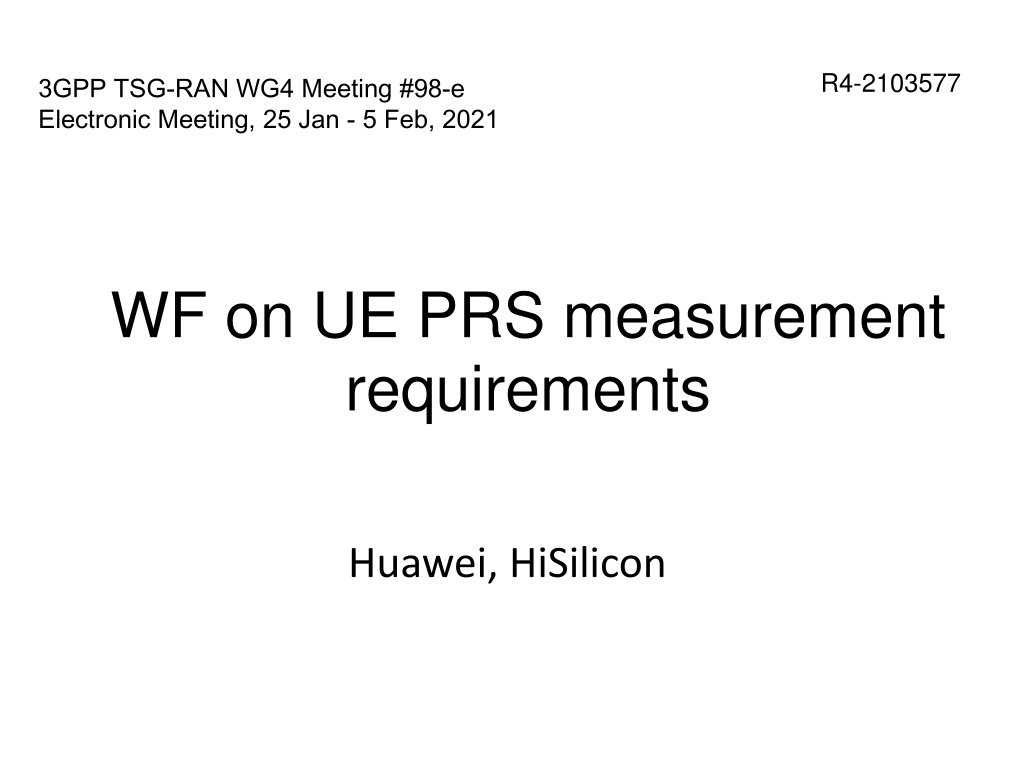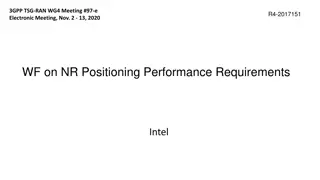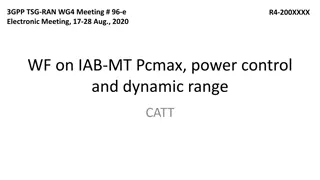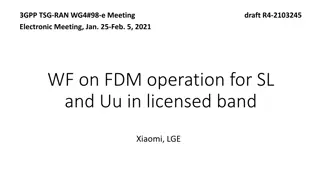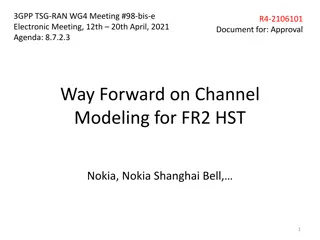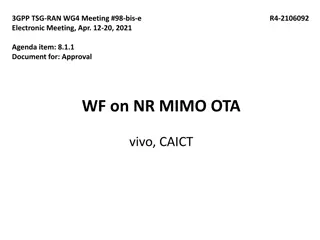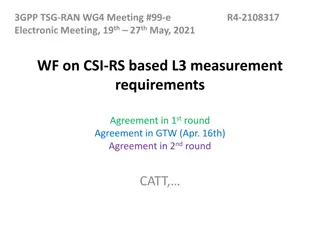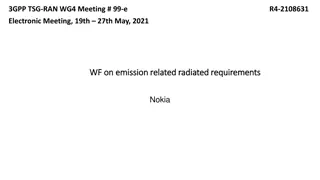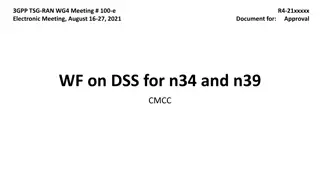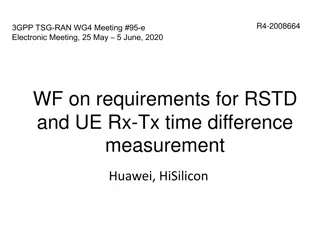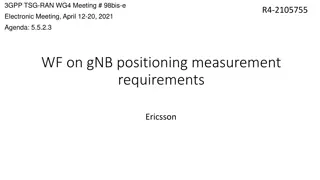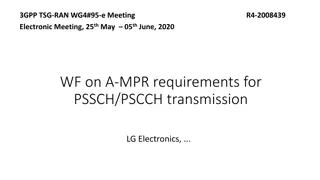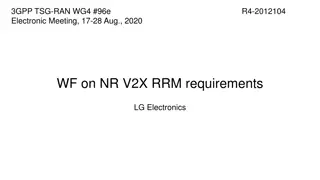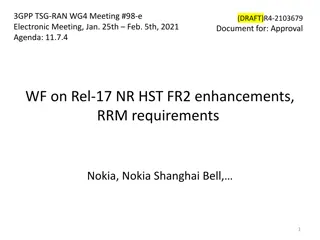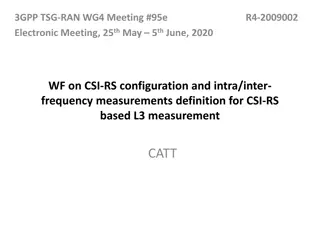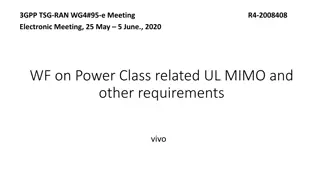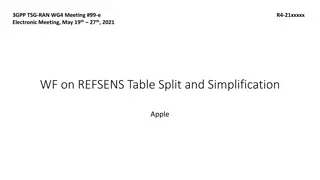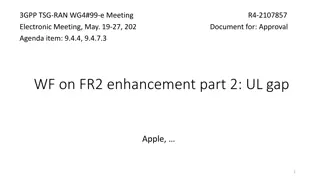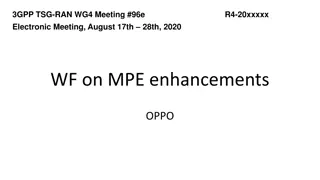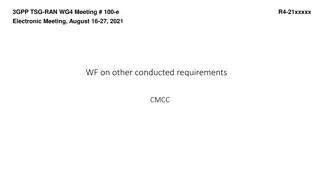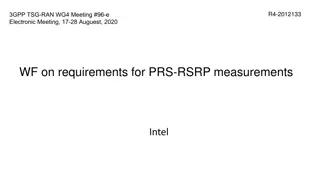UE PRS Measurement Requirements Discussion at 3GPP TSG-RAN WG4 Meeting #98-e
Discussion at the 3GPP TSG-RAN WG4 Meeting #98-e focused on UE PRS measurement requirements. The topics included consideration of muting in measurement periods, periodicity scaling for PRS resources, handling different resource periodicities, and offsets in measurement periods. Various options were proposed and debated, such as scaling based on muting patterns, deriving specific periodicities, extending measurement periods for different resource offsets, and avoiding configurations with varying offsets on the same PFL.
Download Presentation

Please find below an Image/Link to download the presentation.
The content on the website is provided AS IS for your information and personal use only. It may not be sold, licensed, or shared on other websites without obtaining consent from the author. Download presentation by click this link. If you encounter any issues during the download, it is possible that the publisher has removed the file from their server.
E N D
Presentation Transcript
R4-2103577 3GPP TSG-RAN WG4 Meeting #98-e Electronic Meeting, 25 Jan - 5 Feb, 2021 WF on UE PRS measurement requirements Huawei, HiSilicon
Measurement period for RSTD (1) FFS whether and how to account for muting in measurement period requirements Option 1a If muting option 1 is applied, the periodicity of a PRS resource is scaled by Nmuting where Nmutingis X * dl-prs-MutingBitRepetitionFactor, and X is the size of NR- MutingPattern-r16 for mutingOption1-r16 Option 1b If muting option 1 is applied, the periodicity of a PRS resource is scaled by Nmuting where Nmutingis X * dl-prs-MutingBitRepetitionFactor, and X is the [maximum] number of consecutive zeros in NR-MutingPattern-r16 for mutingOption1-r16 Option 2: Muting is accounted with same approach as in LTE (the current requirements apply when up to of PRS resources can be muted) Option 3: Do not define requirements for the case of PRS resource muting in Rel-16
Measurement period for RSTD (2) Consideration on different resource periodicities Use the least common multiple of PRS periodicities among all PRS resources in the PFL FFS: only the PRS resources or resource sets configured which are fully or partly within the MGs should be considered FFS: the need to decide on the order of steps to derive TPRS,i Order for steps to derive TPRS,i Option 1 The applying order to scale the PRS periodicity should be A): The PRS periodicity indicated by NR-DL-PRS-Periodicity-and- ResourceSetSlotOffset-r16 B): Scale the PRS periodicity based on inter-period muting pattern C): Derive the frequency layer specific periodicity (TPRS,i) if multiple periodicities are configured in this layer D): Derive the available periodicity within MGs (Tavailable_PRS,i) E): Derive the effective periodicity based on PRS processing time (Teffect,i) Other options are not precluded
Measurement period for RSTD (3) FFS Consideration on different resource offsets in measurement period Option 1 RSTD measurement period of a single PRS frequency layer is extended by T ms if different PRS resources on the PRS frequency layer have different offsets after muting. Option 2 redefine Tlastas Tlast= ?i+ ??????????_???,i(currently Tlast= ?i+ ????,i) Option 3 No change is needed due to different offsets. Option 4 Avoid PRS configuration with different resource offsets on the same PFL
Measurement period for RSTD (4) Definition of parameter Lprs Refer to clause 5.1.6.5 of 38.214 for calculation of Lprs. The calculation of Lprs should be based on the type (type 1 or type 2) as UE used to report {N,T} Further clarify the description and notations of Lprs in 38.133 (e.g. account PRS resources within MGs; clarify period of time over which Lprs is counted)
Measurement period for RSTD (5) Measurement period of multiple PLFs overlapping case Measurement period of multiple PRS layers is defined as summation of the measurement period in each frequency layer CSSF is only for the MG sharing between PRS and RRM layers. Count only a single PRS layer for a gap occasion in CSSF calculation for both PRS and RRM layers. FFS how to capture the equations in the specifications (need for explicit definition of TRSTD,i) FFS Measurement period of multiple PLFs non-overlapping case Option 1 Requirement of non-overlapping case should be the same as for overlapping case, i.e. sum approach Option 2 Measurement period for the non-overlapping case shall be TRSTD, Total= maxi(TRSTD,i), where the measurement period starts with the first MG and it is the same for all frequencies (agreement from RAN4#96-e). Hence, the time to the last sample across all frequencies will correctly determine TRSTD, Total, regardless of the order the frequencies are measured
Measurement period for RSTD (6) FFS Measurement period of when configured with PRS-RSRP (do we need listing explicitly these scenarios? I think scenario 1 was originally the concern) Scenario #1: PRS-RSRP is configured for DL-TDOA but not other positioning methods Option 1 RSTD measurement period is not impacted by PRS-RSRP measurement. Option 2 UE behavior when RSTD is configured together with PRS-RSRP and the required PRS-RSRP measurement period is longer than that for RSTD (configured without RSTD): the RSTD measurement continues over the entire PRS-RSRP measurement period Scenario #2: PRS-RSRP is configured for another positioning method but not for DL-TDOA Option 1 RSTD measurement period is not impacted by the PRS-RSRP measurement configured for the other positioning method, no matter if PRS- RSRP is configured for TDOA or not. Option 2 RSTD measurement period is not impacted by the PRS-RSRP measurement configured for the other positioning method, provided PRS- RSRP is not configured for TDOA Scenario #3: PRS-RSRP measurements are configured for another positioning method and for DL-TDOA (different PRS resources are used for DL-TDOA and the other method) Option 1 RSTD measurement period is not impacted by the PRS-RSRP measurement configured for the other positioning method, no matter if PRS- RSRP is configured for TDOA or not. Option 2 RSTD measurement period is not impacted by the PRS-RSRP measurement configured for the other positioning methods, provided PRS- RSRP is not configured for TDOA Scenario #4: PRS-RSRP measurements are configured for another positioning method and for DL-TDOA (identical PRS resources are used for DL-TDOA and the other method) Option 1 RSTD measurement period is not impacted by the PRS-RSRP measurement configured for the other positioning method, no matter if PRS- RSRP is configured for TDOA or not. Option 2 RSTD measurement period is not impacted by the PRS-RSRP measurement configured for the other positioning methods, provided PRS- RSRP is not configured for TDOA FFS: need to also consider same or different frequency layers
Measurement period for RSTD (7) FFS clarification of UE behaviour at HO Option 1 Clarify in section 9.9.2.5 of TS 38.133 (clarification is in bold): If intra-frequency or inter-frequency handover occurs while RSTD measurements are being performed, then the UE shall continue and complete the on-going RSTD measurements. Option 2 the RSTD measurement requirements when HO occurs during the measurement are already clearly specified in 38.133 clause 9.9.2.5
Measurement period for PRS-RSRP (1) Measurement period when configured with RSTD or UE Rx-Tx FFS Scenario #1: UE being configured to measure PRS-RSRP for DL-TDOA (or Multi-RTT) UE behavior: Option 1 UE continues PRS-RSRP over the entire RSTD/UE Rx-Tx measurement period, when PRS-RSRP is configured together with RSTD/UE Rx-Tx, and the required PRS-RSRP measurement period is shorter than that for RSTD/UE Rx-Tx (configured without PRS-RSRP) Option 2 UE does not continue PRS-RSRP measurement Applicable PRS-RSRP measurement period requirements Option 1: The minimum measurement period is extended to that for RSTD/UE Rx-Tx Option 2: The minimum measurement period is linked with the accuracy and thus does not need to be extended, but the UE shall continue measuring so the PRS-RSRP matches RSTD/UE Rx-Tx Option 3 Current requirements in clause 9.9.3 also apply for the case when PRS-RSRP is measured for DL- TDOA or Multi-RTT, the UE stops PRS-RSRP measurement Scenario #2: UE being configured to measure PRS-RSRP for different positioning methods If PRS-RSRP measurement is separately configured for each positioning method, the requirements shall be met independently for each positioning method.
Measurement period for UE Rx-Tx (1) FFS Whether SRS periodicity should be accounted in measurement period Option 1 No Option 2 TUE Rx Tx,totalcan be extended if the SRS periodicity is longer than max(TPRS,i). FFS Whether SRS dropping should be accounted in measurement period Option 1 No Option 2 UE is allowed to extend the UE Rx-Tx measurement period (clarified in the requirements), but the exact value is not specified (aligned with RAN4 agreement on PRS dropping)
Measurement period for UE Rx-Tx (2) FFS PRS/SRS proximity Option 1 The measurement requirements for UE Rx-Tx timing difference is applicable only if the configured parameters SRS-Slot-offset and SRS- Periodicity for SRS resource for positioning are such that any SRS transmission is within [-X, +X] ms of at least one DL PRS resource of each of the TRPs in the assistance data X = 50 X = 160 X = 80 Option 2 The requirements for UE Rx-Tx apply provided MIN(Tsrs, Tprs) 2*X; X = FFS (e.g. X = 160 ms) Option 3 The requirements for UE Rx-Tx apply provided MIN(Tsrs, Tprs) Y; Y = FFS (e.g. Y = 320 ms)
Measurement period for UE Rx-Tx (3) FFS Measurement period requirements with TA change TA change due to TA command UE behaviour: Option 1 UE shall continue UE Rx-Tx time difference measurement and meet accuracy requirements Option 2 The UE shall discard the UE Rx-Tx time difference measurement if the uplink transmission timing (based on network-configured TA) changes during the UE Rx-Tx measurement period Applicable measurement period requirements Option 1 the UE Rx-Tx time difference measurement requirement are not applicable TA change due to UE autonomous adjustment UE behaviour: Option 1 UE shall continue UE Rx-Tx time difference measurement and UE Rx-Tx time difference measurement requirements shall apply Option 2 The UE shall discard the UE Rx-Tx time difference measurement if the uplink transmission timing (autonomous) changes during the UE Rx-Tx measurement period TA change due to NTA_offset change Option 1 No need to clarify UE Rx-Tx measurement requirements in case of NTA_offsetchange and the current accuracy requirements apply Option 2 No need to clarify UE Rx-Tx measurement requirements in case of NTA_offsetchange, provided the current accuracy requirements do not apply Option 3 It is clarified in UE Rx-Tx measurement requirements (section 9.9.4 in TS 38.133) that measurement requirements are not applicable if the NTA_offset changes during the measurement period
Measurement period for UE Rx-Tx (4) FFS Measurement period requirements with cell change cell change impacting SRS configuration with SRS Option 1 No need to specify requirements for SRS reconfiguration. Option 2 If the serving cell (PCell, PSCell, or SCell) configured with the SRS for positioning changes during the measurement period, UE Rx-Tx measurement requirements do not apply What is the UE behaviour in this case? Option 3 If the serving cell (PCell, PSCell, or SCell) configured with the SRS for the measurement, changes during the measurement period, UE Rx-Tx time difference measurement is restarted, after the SRS reconfiguration on the target cell is complete. In this case, the UE shall restart the UE Rx-Tx time difference measurement after the SRS reconfiguration on the target cell is complete. cell change not impacting SRS configuration without SRS Option 1 if the serving cell (PSCell or SCell) changes while not configured with the SRS for positioning, the UE shall continue the on-going UE Rx-Tx time difference measurement after the serving cell change the current measurement period applies accuracy requirements in clause 10.1.25 apply Option 2 if the serving cell (PSCell or SCell) changes while not configured with the SRS for positioning, the UE shall continue the on-going UE Rx-Tx time difference measurement after the serving cell change the current measurement period is extended accuracy requirements in clause 10.1.25 apply
CSSF (1) FFS Whether a PLF is considered as candidate for a MG occasion when part but not all resources on that PFL are within the MGL of the MG occasion Option 1 Yes, a PFL is counted as candidate for a MG occasion if at least one PRS resource occasion on that PFL is fully covered by the MGL excluding RF switching time. Option 2 Other Yes, a PFL is counted as candidate for a MG occasion if a sufficient number of PRS symbols are contained within MGL excluding RF switching time FFS for the sum-based approach, Selection of one PFL in CSSF calculation for PRS measurement period Option 1 Only one short periodicity PRS frequency layer with a short periodicity would compete for MG with other gap- based RRM measurements at a time Selection of the one PRS frequency layer for measurement is up to UE implementation Option 2 For PFLs that do not satisfy the long periodicity condition, CSSF would be calculated by counting only one PFL at a time. For RRM frequency layers, N intermediate CSSF values would be calculated, when N is the number of PFLs and each intermediate CSSF value accounts for only one of the PFLs. FFS: The CSSF value for a RRM frequency layer could be the highest among the N intermediate CSSF values or chosen depending on with PFL is being processed at the time. Option 3 CSSF should be defined on per MG occasion basis, i.e. a PRS frequency layer is counted as candidate for a MG occasion if at least one PRS resource occasion is fully covered by the MGL excluding RF switching time. Count only a single PLF for each MG occasion. For the sum-based approach, CSSF for RRM measurements on a carrier frequency with PRS measurements Option 1: Rel-15 approach
CSSF (2) FFS: Definition of long periodicity measurement Option 1 Tavailable,i 320ms . Option 2 max(Tprs * X * dl-prs-MutingBitRepetitionFactor) >=320ms, where X is the length of NR-MutingPattern-r16 for mutingOption1-r16r Option 3 ??????? ??? ?????,??????? set index within a PFL, ????,??????? = ????? dl PRS MultiBitRepetitionFactor ? + 1 , ????? is the PRS resource periodicity and ? ? is the number of consecutive zeros in NR- MutingPattern-r16 for mutingOption1-r16 Option 4 160 ?? where ? is the PRS resource ? ? PRS periodicity (ms) DL-PRS-MutingPattern configuration >160 With or without muting 160 With muting
Requirements applicability considering UE capability (1) FFS: time span of PRS resource instance > N Option 1 The measurement requirements do not apply for a PRS resource, if time span of the PRS resource instance is greater than UE reported capability N Option 2 at least UE should be able to measure one PRS resource without repetition Option 3 No clarification is needed FFS: time span of PRS resource instance > MGL Option 1 The measurement requirements do not apply for a PRS resource, if the time span of a DL PRS resource instance is greater than the configured measurement gap length Option 2 When time span of PRS resource instance > MGL, the PRS within the useful part of MG can be assumed Option 3 The requirements apply , provided a sufficient number of PRS symbols are available within MGL excluding the RF switching time. The PRS symbols beyond MGL are not considered for PRS measurements
Requirements applicability considering UE capability (2) FFS: definition of Lprs,i in 38.133 FFS: time span of PRS resource instance being across two sampling duration of N within duration Lprs Option 1 The measurement requirements do not apply for a PRS resource, if the PRS resource is across two sampling duration of N within duration Lprs Option 2 UE may need to combine the PRS resource in the two sampling periods, or overlapped sampling window can be used if the issue exists Option 3 No clarification is needed Requirements applicability wrt PRS capabilitygeneric principle Option 1 The measurement requirements do not apply to any instance of a PRS resource that cannot be measured and processed in its entirety due to limitations imposed by either the UE PRS processing capability {N, T} or the configured measurement gap pattern. Option 2 No further clarification is needed
Use of MG pattern #24 and #25 for LTE RRM measurement (1) FFS whether MG pattern #25 is an applicable pattern for LTE measurements Option 1 Remove MG pattern #25 as an applicable pattern for LTE measurement Option 2 No change is needed to the current specificationKeep MG pattern #25 as an applicable pattern for LTE measurement FFS Measurement window when MG pattern #24 is used for LTE measurement Option 1 When MG pattern #24 is used for LTE measurement, the measurement window is defined as the first 5ms after the RF re-tuning time Option 2 no need to limit this to 5 ms
